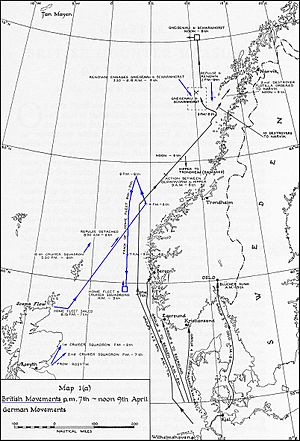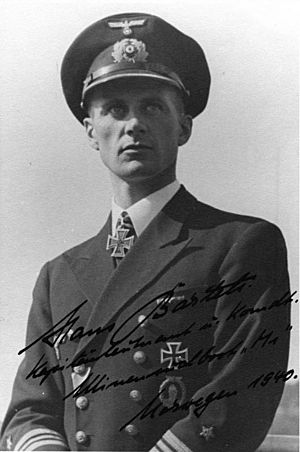Capture of Egersund facts for kids
Quick facts for kids Capture of Egersund |
|||||||||
|---|---|---|---|---|---|---|---|---|---|
| Part of the Invasion of Norway during the Second World War |
|||||||||
|
|||||||||
| Belligerents | |||||||||
| Commanders and leaders | |||||||||
(naval) (land) |
(naval) (land) |
||||||||
| Units involved | |||||||||
|
|
|||||||||
| Strength | |||||||||
| 328 sailors 150 soldiers 4 M class minesweepers (only 2 ships took part) |
17 sailors 36 jägers 1 torpedo boat (Skarv) |
||||||||
| Casualties and losses | |||||||||
| none | 53 captured 1 torpedo boat captured |
||||||||
The Capture of Egersund happened on 9 April 1940. German soldiers, who used bicycles to get around, landed in the Norwegian port town of Egersund. This was part of the German invasion of Norway during the Second World War.
The Germans took over the town without any fighting. They captured the small Norwegian army and navy forces there. Their main goal was to cut the undersea telegraph cable that connected Norway to the United Kingdom.
By taking Egersund, the Germans created one of several landing spots in Norway. This landing helped make Norwegian forces in the Rogaland area move away from the coast. They had to fight the Germans further inland. The Germans then controlled the Rogaland coastline. This allowed them to use Stavanger Airport, Sola as an important base for their air force, the Luftwaffe, in Norway.
At first, the people of Egersund were calm about the invasion. But the next day, panic spread. Rumors of a British bomber attack made many people leave the town quickly.
Contents
Why Egersund Was Important
After the Second World War started in September 1939, Norway said it would stay neutral. This meant Norway would not take sides. However, both sides often broke Norway's neutrality. German submarines, called U-boats, attacked ships in Norwegian waters. The Norwegian Armed Forces were not ready. They were not fully prepared and could not protect Norway's neutrality well.
On 17 February 1940, Adolf Hitler ordered the invasion of Norway. He said he needed to stop a possible British landing in Norway. He also wanted to get iron ore and other resources from Norway. Another reason was to protect Germany's northern side and give the German navy, the Kriegsmarine, easy access to the Atlantic Ocean. General Nikolaus von Falkenhorst was put in charge of the invasion of Norway.
Planning the Attack
When General von Falkenhorst showed his invasion plans to Hitler, Egersund was chosen as a target for the first day. Egersund was important because it had the Norwegian station for an undersea telegraph cable. This cable went from Norway to Peterhead in Scotland. By cutting Norway's links to the outside world, the Germans wanted to stop the Allied forces from getting information about the invasion. It would also help Germans control Norway's communications. They could then use these to calm the people and stop them from fighting back.
Capturing Egersund would also let the Germans cut important road and railway lines that went through the town. The Germans also worried that the good harbor at Egersund could be used by Norwegian or Allied troops. These troops could then attack Stavanger Airport, Sola, which was a big part of the German invasion plans.
The Norwegian Armed Forces knew how important the Rogaland region was. Egersund is in this region. In 1939, they changed their war plans for the local 8th Infantry Regiment. This regiment was meant to go to Kristiansand if there was a war. But in 1939, the plans changed. The regiment would now focus on defending the Rogaland region. Egersund was one of the places where landings were feared. So, Årstaddalen near Egersund was chosen as a meeting place for two companies of soldiers. A supply depot was also set up there.
German Ships Set Sail
Egersund was to be taken by Gruppe 6. This was the smallest of the six German invasion groups of ships. Gruppe 6 left Cuxhaven at 5:45 AM on 8 April. Before leaving, the soldiers were told that the Norwegian people would "receive them as friends." On their way north, Gruppe 6 sailed with other German ships that were going to capture Denmark.
Off the coast of Denmark, Gruppe 6 went on alone towards Norway. The weather was bad with strong winds and poor visibility. By the early morning of 9 April, the ships of Gruppe 6 lost sight of each other. Only M-1 and M-9 managed to stay together in the fog. They continued towards Egersund.
Forces Involved
German Forces
The German force sent to Egersund had four minesweepers. These ships carried 150 soldiers from a bicycle unit. This unit was part of the 69th Infantry Division. Its commander was Friedrich Eickhorn. The bicycle unit traveled by train from their base to the port on 7 April 1940.
The minesweepers were M-1, M-2, M-9, and M-13. Kurt Thoma commanded the ships from M-9. The minesweepers had a total of 328 officers and sailors.
Norwegian Forces
The torpedo boat Skarv was based at Egersund. It was a small, 84-ton torpedo boat launched in 1906. Another modern destroyer, Gyller, was also based there. But on 9 April, Gyller was away on a mission.
On 8 April, Skarv was told to be ready for action. Skarv was led by Hjalmar Svae and had a crew of 17. Svae asked to patrol outside the port, but his commanders told him to stay in the harbor.
Egersund did not have a permanent army base. But on 8 April 1940, a 36-man Jeger (hunter) platoon was ordered to move into the town. This unit, led by Captain Carsten Dehli, arrived by train late on 8 April.
The Landing
Around 4:00 AM on 9 April 1940, M-1 and M-9 saw Egersund. M-9 stayed outside the port to guard the waters. The smaller M-1, carrying Friedrich Eickhorn and 40 soldiers, entered Egersund harbor. At 4:15 AM, the Germans landed near the torpedo boat Skarv. The guard on Skarv first thought M-1 was Gyller returning.
The German troops quickly boarded and took over the torpedo boat. After being captured, the crew of Skarv managed to destroy maps and important papers. They also made a phone call to their naval headquarters. Soon, the captured Norwegian sailors were locked in a shed under guard.
Captain Dehli had contacted Skarv earlier to plan their defense. But this contact was not enough. An army observation post saw the German ships just before they landed. This information was not sent to Skarv.
After taking the harbor area, M-1 took M-9's place outside the port. This allowed M-9 to land its soldiers. While 12 soldiers guarded the harbor, the rest of the German troops spread out. They took over important places like the telephone and post office, the police station, and the railway station. They also guarded the harbor entrance.
Captain Dehli reported to his commanders in Stavanger that "a large invasion force" had landed. Soon after, he and his army unit were surprised in their quarters and captured. They did not fight back. The sailors captured earlier were later moved to the same building and held there. Skarv formally surrendered later that day. Sub-lieutenant Svae handed his sword to Eickhorn.
An hour after Egersund was captured, the other two German minesweepers, M-2 and M-13, arrived. After all the soldiers and equipment were unloaded, the four minesweepers headed back to Kiel in Germany. Later, they were ordered to go to Kristiansand to help there. The German forces attacking Kristiansand faced strong resistance. But the city was secured before the Gruppe 6 minesweepers arrived that afternoon.
The Allied forces did not directly try to stop the German capture of Egersund. But later that day, a British plane flew over the area. It counted 18 German aircraft in the sky above the town.
What Happened Next
After capturing Egersund, Friedrich Eickhorn first put guards on the telegraph cable to Scotland. Later, he cut the communication link as he was ordered. The German landing spot at Egersund was cut off from other German forces at first. This was because their radios did not work well, and Norwegians cut the phone lines. Eventually, they contacted the German units in Stavanger. An officer on a motorcycle, dressed as a civilian, delivered the message. Before the Germans took control of the areas around Egersund's town center, the Norwegian supply depot at Årstaddalen was emptied.
Captain Dehli's report about the German forces in Egersund was not fully accurate. This made the Norwegian commander in Stavanger, Colonel Gunnar Spørck, pull his forces back from the coast. They set up defenses further inland. This Norwegian retreat allowed the Germans to bring in more forces. They could then use Sola airport as a base for their air force. From Sola, German bombers controlled the waters of the Skagerrak and the eastern North Sea. After heavy fighting, the Norwegian forces in the region surrendered in late April 1940.
Some people from Egersund left the town soon after the German landing. They joined the Norwegian units fighting the invasion. The German unit that captured Egersund also fought against Norwegian forces from mid-April onwards.
After taking Egersund, Friedrich Eickhorn started to enforce German rule. Cars and trucks were taken for the German army. Local newspapers were told to follow German orders and print German messages. A blackout was also started, meaning lights had to be turned off at night.
At first, the people of Egersund were calm. But on 10 April, panic broke out. Rumors spread that 600 British bombers were about to attack the town. Even though Germans and town officials tried to calm people, almost everyone fled to the countryside within an hour. Only Germans and some town workers were left. Similar panic happened in other Norwegian towns that day, especially in Oslo.
The Norwegian prisoners of war taken in Egersund were made to work on an air base in Stavanger. They were released in June 1940. Skarv was used by the German navy and renamed Gazelle. It was lost in a collision in 1942.
The last Norwegian forces still fighting surrendered on 9 June 1940. This ended the 62-day Norwegian campaign. The Norwegian Armed Forces then continued fighting the Germans from exile in the United Kingdom.
In 1941, the commander of M-1, Hans Bartels, wrote a book about his experiences during the invasion of Norway.
After the Second World War ended, the capture of Egersund was looked into by a special commission in 1946. The commission decided that no one was to blame for Egersund and its forces being lost.
Images for kids
-
The commander of M-1, Hans Bartels, in Norway in 1940. Bartels wrote the book Tigerflagge heiß vor! about his participation in the invasion of Norway







